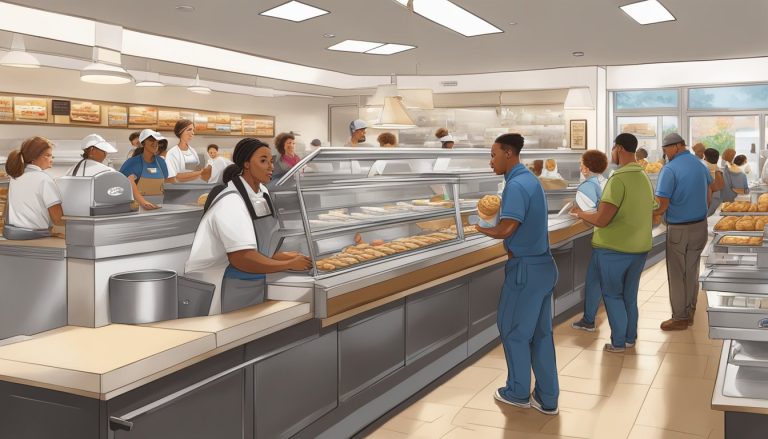Chick-fil-A’s journey from a small diner to a fast-food empire is a testament to its innovation and commitment to quality. The company’s breakfast menu has played a significant role in its evolution, offering a unique take on morning meals in the competitive fast-food landscape. Chick-fil-A’s breakfast options, including its signature Chicken Biscuit, have become a cornerstone of its success, contributing to its position as one of the top fast-food chains in the United States.
The introduction of breakfast items at Chick-fil-A marked a pivotal moment in the company’s history. By expanding beyond its original chicken sandwich, Chick-fil-A demonstrated its ability to adapt to changing consumer preferences while maintaining its core values. This move not only broadened its customer base but also set new standards for breakfast offerings in the fast-food industry.
Chick-fil-A’s approach to breakfast reflects the broader evolution of fast food. As customer expectations have grown, the company has responded with a menu that balances traditional favorites with healthier options. This strategy has helped Chick-fil-A maintain its relevance and popularity in an ever-changing market, solidifying its place as a beloved brand in American fast-food culture.
The Origins and Founder of Chick-fil-A
Chick-fil-A’s story begins with S. Truett Cathy and his small diner in Hapeville, Georgia. The company’s growth from a local eatery to a national fast-food chain reflects Cathy’s entrepreneurial spirit and commitment to quality.
Truett Cathy and the Dwarf Grill
S. Truett Cathy opened the Dwarf Grill in Hapeville, Georgia in 1946. The tiny diner, named for its small size, became the birthplace of Chick-fil-A’s signature item. Cathy experimented with chicken recipes, eventually creating the chicken sandwich that would define the brand.
The Dwarf Grill’s proximity to the Ford Motor Company plant ensured a steady stream of customers. Cathy’s focus on fresh, quality food and customer service laid the foundation for his future success.
Expanding Beyond Hapeville, Georgia
In 1967, Cathy opened the first Chick-fil-A restaurant in Atlanta’s Greenbriar Mall. This marked the beginning of the company’s expansion beyond its original location. Cathy’s innovative approach to fast food, centered on the chicken sandwich, set Chick-fil-A apart in the market.
The company grew steadily, opening locations across the Southern United States. Cathy’s business model, which included closing on Sundays and fostering a family-oriented corporate culture, became hallmarks of the brand.
By the early 2000s, Chick-fil-A had expanded nationwide, transforming from a regional chain to a national fast-food powerhouse. The company maintained its commitment to Cathy’s original values throughout its growth.
From Single Restaurant to Renowned Chain

Chick-fil-A’s journey from a small diner to a fast-food powerhouse is a tale of innovation, strategic growth, and unwavering commitment to quality. The company’s expansion was fueled by its signature chicken sandwich, a unique franchise model, and targeted expansion efforts.
The Birth of the Original Chicken Sandwich
In 1946, S. Truett Cathy opened the Dwarf Grill in Hapeville, Georgia. This small diner became the birthplace of Chick-fil-A’s famous chicken sandwich. Cathy experimented with different recipes, eventually creating a boneless chicken fillet sandwich in 1964.
The sandwich’s popularity grew rapidly, prompting Cathy to patent his cooking method in 1963. This unique process ensured the chicken remained juicy and flavorful, setting it apart from competitors.
In 1967, Cathy opened the first Chick-fil-A restaurant in Atlanta’s Greenbriar Mall. This move was revolutionary, as it was one of the first fast-food establishments in a shopping mall.
Growth Through Franchising
Chick-fil-A adopted a distinctive franchise model that contributed significantly to its growth. Unlike traditional franchising, Chick-fil-A’s approach involved low initial investment and a profit-sharing system.
The company carefully selected franchisees based on character and leadership skills rather than financial capacity. This strategy ensured that operators aligned with Chick-fil-A’s values and service standards.
Franchisees were required to be hands-on in their restaurants, fostering a sense of ownership and commitment. This model proved successful, leading to rapid expansion and consistently high customer satisfaction ratings.
National Expansion and Customer Base
By the 1980s, Chick-fil-A began expanding beyond its Southern roots. The company strategically opened locations in suburban areas and near colleges, attracting a diverse customer base.
Chick-fil-A’s commitment to quality and customer service helped it build a loyal following. The chain introduced innovative menu items while maintaining its focus on the original chicken sandwich.
The company’s philanthropic efforts, including scholarship programs and community initiatives, further enhanced its reputation. These actions helped Chick-fil-A establish deep connections with local communities across the country.
By 2000, Chick-fil-A had over 1,000 locations nationwide. Its expansion continued steadily, with plans to open international locations in the coming years.
Menu Evolution and Signature Items

Chick-fil-A’s breakfast menu has undergone significant changes since its inception in the 1980s, adapting to customer preferences while maintaining its core identity. The chain’s commitment to quality and service has shaped its offerings, with several items becoming enduring favorites.
Innovation and Introduction of New Items
Chick-fil-A has continuously innovated its breakfast menu to stay competitive. The introduction of the Chicken Biscuit in 1986 marked a turning point, combining their signature breaded chicken breast with a freshly baked biscuit. This item quickly became a breakfast staple.
In recent years, the chain has expanded its options to cater to health-conscious customers. The Egg White Grill, featuring grilled chicken and egg whites on an English muffin, was added as a lighter alternative.
The Hash Brown Scramble Bowl, introduced in 2017, offers a hearty option combining hash browns, scrambled eggs, and chicken nuggets or sausage.
Maintaining the Core: Quality and Service
Despite menu changes, Chick-fil-A has maintained its focus on quality ingredients and attentive service. The chain uses hand-breaded chicken and freshly prepared biscuits daily.
Their commitment to customer satisfaction extends to breakfast hours, with most locations serving from 6:30 AM to 10:30 AM.
Chick-fil-A’s breakfast menu prices reflect the quality of ingredients used, typically ranging from $2 to $5 per item.
The Role of Customer Favorites
Several breakfast items have become customer favorites, shaping the menu’s evolution. The Chick-n-Minis, bite-sized chicken nuggets nestled in miniature yeast rolls, have gained a devoted following since their introduction.
The Spicy Chicken Biscuit, a variation on the original, caters to those seeking a bolder flavor profile.
Breakfast platters, featuring items like chicken, eggs, and biscuits, have remained popular for those wanting a more substantial meal.
Chick-fil-A’s distinctive breakfast menu, centered around chicken-based items, sets it apart from competitors who often focus on traditional breakfast meats like bacon and sausage.
Customer Experience and Business Model
Chick-fil-A’s success stems from its dedication to customer satisfaction and innovative business practices. The company has built a loyal following through its commitment to quality service and efficient operations.
Exceptional Customer Service as a Hallmark
Chick-fil-A prioritizes customer service as a core element of its business model. Employees are trained to be polite and attentive, often using phrases like “my pleasure” in interactions with guests. This approach has helped build a strong brand reputation.
The company focuses on creating a positive dining experience. Restaurants are designed to be clean and welcoming, with staff members often going above and beyond to assist customers. This includes bringing food to tables and offering refills.
Chick-fil-A’s limited menu allows for faster service and consistent quality. By specializing in chicken sandwiches, the company maintains high standards across all locations.
Leveraging Digital Technology for Efficiency
Chick-fil-A has embraced digital innovation to enhance customer experience and streamline operations. The company’s mobile app allows for easy ordering and payment, reducing wait times and improving convenience.
Drive-thru service has been optimized with multiple lanes and outdoor order-taking. This innovation has significantly increased efficiency, especially during peak hours.
Digital menu boards and kitchen management systems help staff process orders quickly and accurately. These technologies contribute to shorter wait times and improved order accuracy.
Chick-fil-A’s loyalty program, integrated into its digital platforms, encourages repeat visits and provides valuable customer data for targeted marketing efforts.
Brand Philosophy and Community Impact

Chick-fil-A’s brand philosophy extends beyond serving quality food to making a positive impact on communities. The company emphasizes corporate responsibility and invests in education and development programs.
Corporate Responsibility and Giving Back
Chick-fil-A demonstrates a strong commitment to community engagement through various initiatives. The Chick-fil-A Foundation supports local organizations focused on youth and education. In 2024, the foundation donated over $25 million to community programs across the United States.
The company’s corporate values emphasize service and hospitality. This philosophy extends to philanthropic efforts, including disaster relief and food donations to those in need.
Chick-fil-A also prioritizes environmental sustainability. The company has implemented recycling programs and reduced water usage in its restaurants.
Education and Development Programs
Chick-fil-A invests heavily in education and employee development. The company offers scholarships to team members pursuing higher education. Since 1973, Chick-fil-A has awarded over $100 million in educational assistance to more than 80,000 employees.
The Leadership Development Program provides training for restaurant operators and managers. This initiative focuses on building leadership skills and fostering career growth within the company.
Chick-fil-A also supports youth development through its Chick-fil-A Leader Academy. This program partners with high schools to cultivate leadership skills in students.
Overcoming Challenges and Adapting to Change

Chick-fil-A has demonstrated remarkable resilience in the face of industry shifts and global crises. The company’s ability to innovate and adapt has been crucial to its continued success in the competitive fast-food landscape.
Responses to Industry Changes
Chick-fil-A has consistently evolved its operations to meet changing consumer demands. The company introduced mobile ordering and payment systems to streamline the customer experience. This innovation reduced wait times and increased efficiency, particularly in busy food court locations.
Chick-fil-A also experimented with new restaurant formats. They launched drive-thru-only locations in urban areas with limited space. These compact stores allowed the chain to expand into previously untapped markets.
The company invested in menu diversification, adding healthier options like grilled chicken and salads. This move helped attract health-conscious customers without alienating their core audience.
Adaptation during the COVID-19 Pandemic
The COVID-19 pandemic presented unprecedented challenges for the fast-food industry. Chick-fil-A responded swiftly with enhanced safety measures. They implemented contactless delivery and curbside pickup options.
Drive-thru operations were optimized to handle increased traffic. The company deployed additional staff to manage outdoor orders and improve efficiency.
Chick-fil-A leveraged technology to support social distancing. They expanded their mobile app capabilities and introduced QR code menus to minimize physical contact.
The chain also focused on supporting local communities. They launched initiatives to provide meals to healthcare workers and first responders, strengthening their brand image during the crisis.




